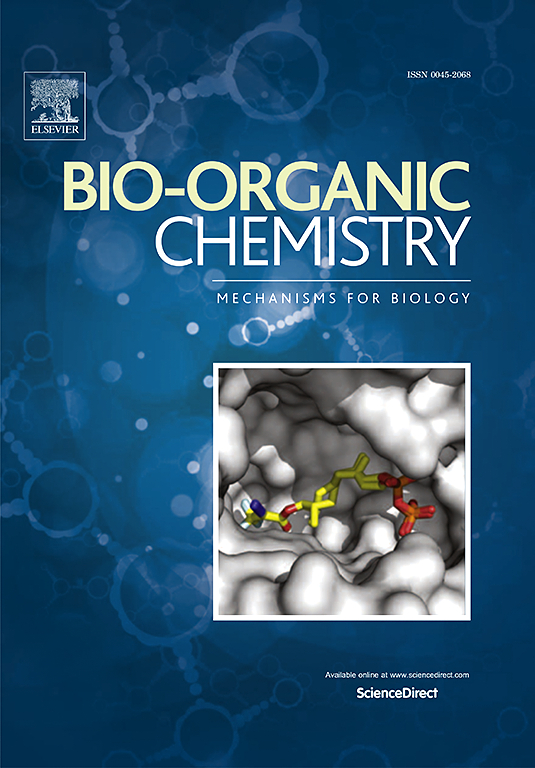作为PDE4B抑制剂的二基氧苯基杂化物:设计、合成、体外/体内抗炎活性和计算机洞察
IF 4.5
2区 医学
Q1 BIOCHEMISTRY & MOLECULAR BIOLOGY
引用次数: 0
摘要
设计并合成了一系列具有抗炎活性的PDE4抑制剂双基氧苯基化合物11a-11h和12a-12c。所有化合物对PDE4B和PDE4D亚型均表现出纳米级抑制活性,对PDE4B具有显著的选择性。3,4-二甲氧基苯基衍生物11e具有较好的PDE4B抑制活性(IC50 = 2.82 nM),选择性为Rolipram的1.5倍。在TNF-α抑制实验中,11e表现出显著的效价(IC50 = 7.20 nM),与罗氟司特相当,其次是11d (IC50 = 15.54 nM)和11b (IC50 = 28.52 nM)。通过lps诱导的脓毒症模型进行的体内评估显示,与参比化合物相比,11e对TNF-α(52.19%)和中性粒细胞(56.47%)的抑制作用最高。分子对接和动力学研究表明,杂种11b、11d和11e在PDE4活性位点内表现出特有的结合模式,通过特异性相互作用使其活性合理化,与罗氟司特相比,在活性位点表现出更高的稳定性。本文章由计算机程序翻译,如有差异,请以英文原文为准。

Dialkyloxyphenyl hybrids as PDE4B inhibitors: Design, synthesis, in vitro/in vivo anti-inflammatory activity and in silico insights
A series of novel dialkyloxyphenyl hybrids 11a-11h and 12a-12c were designed and synthesized as PDE4 inhibitors with anti-inflammatory activity. All compounds demonstrated nanomolar-range inhibitory activity against both PDE4B and PDE4D isoforms with notable selectivity for PDE4B. The 3,4-dimethoxyphenyl derivative 11e exhibited superior PDE4B inhibitory activity (IC50 = 2.82 nM), with nine-fold selectivity compared to 1.5 of Rolipram. In TNF-α inhibition assays, 11e demonstrated remarkable potency (IC50 = 7.20 nM), comparable to roflumilast, followed by 11d (IC50 = 15.54 nM) and 11b (IC50 = 28.52 nM). In vivo evaluation using LPS-induced sepsis model revealed that 11e achieved the highest inhibition of both TNF-α (52.19 %) and neutrophilia (56.47 %) compared to reference compounds. Molecular docking and dynamics studies revealed that hybrids 11b, 11d, and 11e exhibit a characteristic binding mode within the PDE4 active sites, rationalizing their activity through specific interactions, and demonstrating higher stability in the active site compared to Roflumilast.
求助全文
通过发布文献求助,成功后即可免费获取论文全文。
去求助
来源期刊

Bioorganic Chemistry
生物-生化与分子生物学
CiteScore
9.70
自引率
3.90%
发文量
679
审稿时长
31 days
期刊介绍:
Bioorganic Chemistry publishes research that addresses biological questions at the molecular level, using organic chemistry and principles of physical organic chemistry. The scope of the journal covers a range of topics at the organic chemistry-biology interface, including: enzyme catalysis, biotransformation and enzyme inhibition; nucleic acids chemistry; medicinal chemistry; natural product chemistry, natural product synthesis and natural product biosynthesis; antimicrobial agents; lipid and peptide chemistry; biophysical chemistry; biological probes; bio-orthogonal chemistry and biomimetic chemistry.
For manuscripts dealing with synthetic bioactive compounds, the Journal requires that the molecular target of the compounds described must be known, and must be demonstrated experimentally in the manuscript. For studies involving natural products, if the molecular target is unknown, some data beyond simple cell-based toxicity studies to provide insight into the mechanism of action is required. Studies supported by molecular docking are welcome, but must be supported by experimental data. The Journal does not consider manuscripts that are purely theoretical or computational in nature.
The Journal publishes regular articles, short communications and reviews. Reviews are normally invited by Editors or Editorial Board members. Authors of unsolicited reviews should first contact an Editor or Editorial Board member to determine whether the proposed article is within the scope of the Journal.
 求助内容:
求助内容: 应助结果提醒方式:
应助结果提醒方式:


